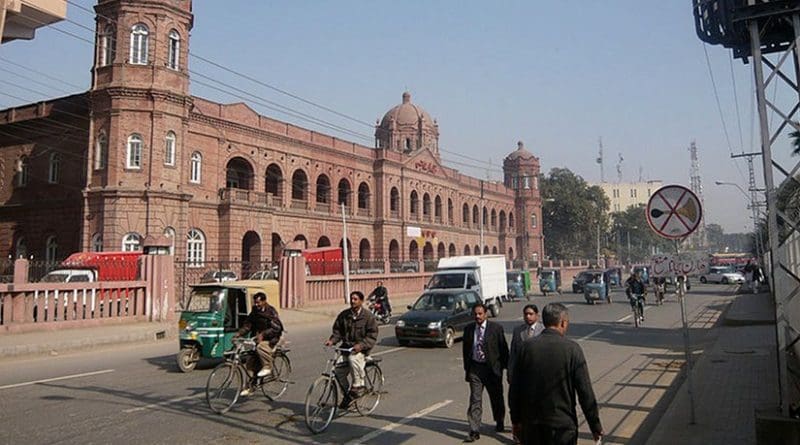Pakistan In Context: NA-120 Lahore By-Election – Analysis
By IPCS
By Sarral Sharma*
The by-election for Lahore’s National Assembly constituency (NA)-120 – previously NA-95 – seat will take place on 17 September. The seat fell vacant after the disqualification of Pakistan’s Prime Minister Nawaz Sharif’s on 28 July following the Supreme Court verdict in the Panama Papers case. Through an assessment of the contesting candidates and their political agendas for the election, this article seeks to determine who stands the likeliest chance of winning, and why.
There are 44 candidates contesting for this seat; but the two key contenders are Pakistan Muslim League-Nawaz’s (PML-N) candidate, Begum Kulsoom Nawaz Sharif, and Pakistan Tehreek-e-Insaf’s (PTI) candidate, Dr Yasmin Rashid. Other notable candidates include Pakistan People’s Party’s (PPP) Faisal Mir, Jamaat-e-Islami’s (JeI) Ziauddin Ansari, and independent candidate, Qari Yaqoob Sheikh, and they may have a limited role to play in the upcoming election.
The PML-N might not find it difficult to win the NA-120 constituency given how Nawaz Sharif won from the NA-120 seat five consecutive times, in 1985, 1988, 1990, 1993 and 1997. The constituency is regarded as Sharif’s stronghold. The party has fielded Kulsoom Nawaz despite her serious illness, and Maryam Nawaz is tasked with leading the political campaign. Incidentally, Kulsoom and Maryam are Nawaz’s spouse and daughter respectively. Amid reports of a possible political feud in the Sharif family with Hamza Sharif – son of Punjab Chief Minister Shahbaz Sharif – withdrew from electioneering. This would be viewed as Maryam’s political anointment as Nawaz’s potential political heir.
The PML-N appears to be focusing on consolidating its electoral base in both Province of Punjab (PP) constituencies, PP-139 and PP-140, which fall under NA-120. In the 2013 election, Sharif won a 10,000-vote lead in PP-140 compared to the lead of over 30,000 votes in PP-139 against PTI’s Rashid. Therefore, the party’s agenda is also to improve the overall tally in both the provincial constituencies in order to create a strong political base before the 2018 general election. More importantly, a win with a comfortable margin will prove critical for the PML-N’s future in Punjab, and to an extent, might also address the doubts some have raised regarding Maryam’s leadership. Still, factors such as a possible anti-incumbency sentiment, party infighting and the impact of the Panama papers trial on local electorate might limit their victory margin.
The PTI has again fielded Yasmin Rashid, who lost to Nawaz in the 2013 election. Rashid views Nawaz’s disqualification as an opportunity to avenge her defeat in the previous election. Despite being the PML-N’s home turf, representatives of the NA-120 constituency and the Punjab government have been accused of indifference due to the sorry state of infrastructure including poor roads, regular power outages, dismal sanitation facilities and unavailability of clean drinking water. Rashid has chosen door-to-door campaigning as well as addressing Mohalla (local area) meetings and erecting party flexes and banners highlighting local issues related to lack of basic amenities in the constituency.
Former PPP supporters as well as some PML-N supporters now disenchanted with the Party, and the youth constitute the PTI’s core electoral base. PTI Chief Imran Khan, who had previously participated in electioneering, is not active this time, possibly because the Election Commission of Pakistan enforced a code of conduct barring campaigning by parliamentarians. Yet, he held a rally in Lahore on 8 September, outside the NA-120 constituency, to seek support for Rashid and to boost the party cadres’ morale. PTI’s win in the by-election may prove to be a referendum against the PML-N government ahead of the 2018 general elections. More importantly, Khan will stand vindicated in his anti-corruption campaign.
PPP’s Faisal Mir too is in the fray with the Party’s old guard trying to re-enter Punjab politics after an embarrassing defeat in 2013. Although the PPP may not make a big impact in this election, the party is putting its best foot forward to prepare for the 2018 polls. Some PPP loyalists who supported PTI’s Rashid in 2013 have reportedly returned to the former party’s fold since Mir’s nomination. However, the weak central leadership and limited political outreach outside Sindh province may dampen the party’s future in Punjab. Still, it is possible that the PPP could improve its overall electoral standing and may make a dent in the opposition parties’ vote share.
Other smaller contenders such as the Jamaat-e-Islami (JeI), and the new entrant Qari Yaqoob Sheikh, an independent nominee supported by Hafiz Saeed’s Jamaat ud Dawa (JuD), might garner some support from right wing voters in the constituency. However, the main contest will be between the two main opposition parties. If the PTI wins the upcoming by-election, it may signal a possible shift in Pakistan’s political setup which might be more visible as the country goes for polls in 2018. Conclusively, Nawaz’s political (and personal) image and Maryam’s future as a potential leader of the PML-N are at stake in this election.
* Sarral Sharma
Researcher, IReS, IPCS
E-mail: [email protected]

